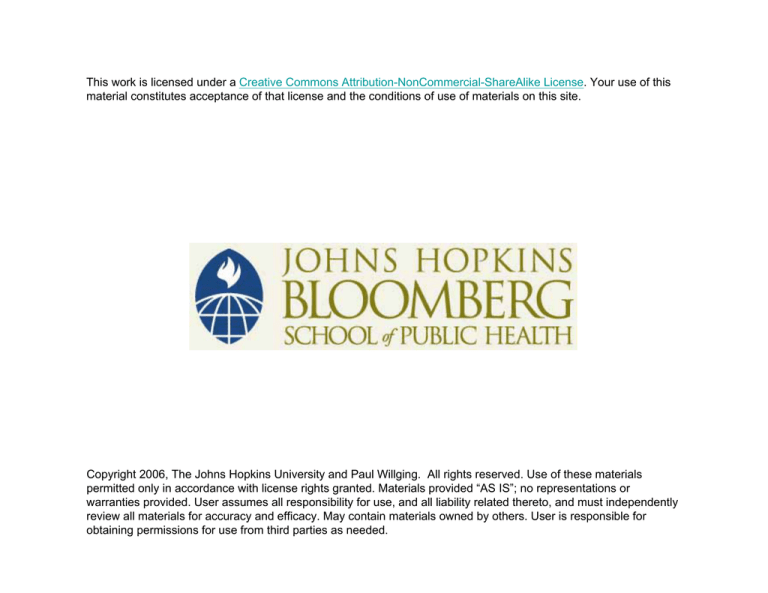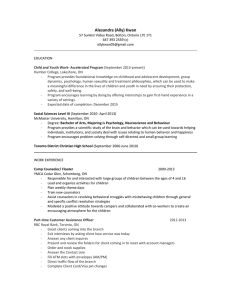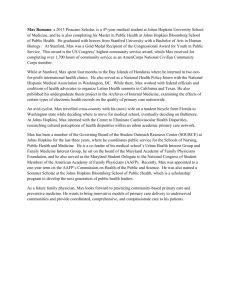
This work is licensed under a Creative Commons Attribution-NonCommercial-ShareAlike License. Your use of this
material constitutes acceptance of that license and the conditions of use of materials on this site.
Copyright 2006, The Johns Hopkins University and Paul Willging. All rights reserved. Use of these materials
permitted only in accordance with license rights granted. Materials provided “AS IS”; no representations or
warranties provided. User assumes all responsibility for use, and all liability related thereto, and must independently
review all materials for accuracy and efficacy. May contain materials owned by others. User is responsible for
obtaining permissions for use from third parties as needed.
The Johns Hopkins Bloomberg School of Public Health
“Managing Long-Term Care Services for Aging Populations”
NOTES:
The Increasing Importance of
Customer Choice
PUBLIC ATTITUDES AND THE MARKETPLACE
UNDERSTANDING THE CUSTOMER
CUSTOMER DEMAND AND PRODUCT ORIENTATION
THE ROLE OF FAMILY
1
Consumers are becoming more demanding about the services they receive. They expect greater responsiveness to their
needs, more convenience (as evidenced by the increasing number of businesses open 24 hours/day), and services that respond
to their needs, not the provider’s.
Consumers’ greater education and awareness are also factors, perhaps a direct result of the activism of the 60s and 70s.
As options become more available, seniors’ expectation will
increase, requiring a higher level of service from housing
facilities.
Module 5: The Increasing Importance of Customer Choice
Page 5-1
The Johns Hopkins Bloomberg School of Public Health
“Managing Long-Term Care Services for Aging Populations”
The Consumer’s Voice
in Health Care Delivery
The implication for assisted living and other senior care
providers: Meet consumers’ needs or go out of business.
NOTES:
• “Doctor Knows Best”
• The Nursing Home Franchise
• The Changing Face of Long Term Care
– Greater Senior Wealth
– Greater Senior Awareness
– Greater Senior Education
2
The health care system has thus far failed to meet consumers’ demands.
With few exceptions, providers are still
available only during most consumers’ work hours; keeping
patients waiting is a common if not standard practice; and
many physicians and other service providers have little to say
to a patient about his or her condition.
The time may come when patients—consumers—demand
the same kind of service from their health care as they expect
from other businesses.
Module 5: The Increasing Importance of Customer Choice
Page 5-2
The Johns Hopkins Bloomberg School of Public Health
“Managing Long-Term Care Services for Aging Populations”
•
Assisted Living vs.
Nursing Home Care
•
•
•
•
less (depending on acuity)
•
•
pleasant,
“natural”
environment
than
the
Independence and freedom to make one’s own
decisions
•
The dignity of private living quarters
•
Greater choice in activities and other aspects of daily
life
•
3
The opportunity to care for one’s self to the extent
possible
Throughout this course, we have emphasized the two key
Such benefits can be a major selling point for assisted
living.
customers in seniors housing:
Those driven by need: residents and, often, their
families
•
More
institutional feel of nursing homes
First Impressions
Environment
Affordability
Focus
– Independence
– Dignity
– Choice
•
More affordable than nursing home care—up to 30%
Market representatives: Federal and state programs; to
NOTES:
a lesser extent, private funding sources
By its nature, assisted living offers several benefits to its
real customers: potential residents and their families.
The
facilities offer the following benefits:
Module 5: The Increasing Importance of Customer Choice
Page 5-3
The Johns Hopkins Bloomberg School of Public Health
“Managing Long-Term Care Services for Aging Populations”
Know Who Your
Market Is Not
The honeymoon may be ending, however, as reflected in a
chapter in the recently released Consumer’s Reports’
“Complete Guide to Health Services for Seniors:”
“People who have been loners all their lives are unlikely to
enjoy the communal nature of assisted living.”
• Nursing Home Example
– Confused Payer with Customer
– Bought into Government Specifications
– Product Nobody Wanted
“Don’t base a decision on (a facility’s information packet).
Most likely it won’t tell you one-tenth of what you need to
know.”
• Keep the Customer Focus
“…In some facilities, you may have to use the doctor the
facility provides.”
– Resident
– Family
4
An assisted living facility can only be successful if it is
“It’s not uncommon for residents to live in several units
during their stay in assisted living, first in a private unit and
then, as money runs low, in a shared room, perhaps in an
undesirable wing or floor.”
market-driven—recognizing that there are two “markets,” but
only one real “customer;”
“Discharge from the facility is basically an eviction.”
•
The funding agency (primarily the Federal Government)
•
The resident and the resident’s family
to downright false. The reader, however, is left with a negative
Thus far, assisted living has escaped the stigma associated
impression of assisted living based on comments in a highly
with nursing homes, largely because it has focused almost
These and similar statements range from grossly subjective
read and respected consumer publication.
exclusively on the customer and not on the secondary
(governmental) market.
Module 5: The Increasing Importance of Customer Choice
Page 5-4
The Johns Hopkins Bloomberg School of Public Health
“Managing Long-Term Care Services for Aging Populations”
Changing Role of
Funding Sources
•
Medicaid is still an insignificant source of assisted
living funding, but over half the states now have a
Medicaid “waiver” allowing them to cover AL as a
benefit under the program. With that funding might
• 75% of Nursing Home Residents Publicly
Funded
• 5% of Assisted Living
• Almost No Congregate and Independent
Living
• On the Horizon
come even greater scrutiny of the product (and, potentially, greater regulatory oversight at the federal level).
The danger of course is the possibility of confusion as
to who is the “customer.”
– Managed Care (Including HMOs)
– Long Term Care Insurance
– Medicaid
NOTES:
5
Unlike nursing facilities, funding for assisted living is
almost entirely private. However, several factors may change
the financing of such facilities:
•
Long-term care insurance could provide alternative
financing; however, only 3% of the potential market
has such insurance, so it is unlikely to be a significant
factor in the foreseeable future.
•
Managed care may provide coverage for disabled
people under 65, providing an additional market.
Module 5: The Increasing Importance of Customer Choice
Page 5-5
The Johns Hopkins Bloomberg School of Public Health
“Managing Long-Term Care Services for Aging Populations”
The Critical
Role of Family
Seniors without disabilities are much less likely to be living
in a relative's home. In 1998, 17% of senior women and 7% of
senior men lived with family members.
Family members play an important role in pursuing assisted
• Family as Caregiver
living and locating a specific facility, as reflected in the “NIC
– 83% of Care Provided by Families
National Survey of Adult Children:”
• Family as Decision Maker
– 75% Involved in Decisions re. Assisted Living
•
• Family as Financial Support
–
–
–
–
52% of assisted living residents learned of the facility
through sons or daughters.
31% of Home Care Recipients
26% of AL Residents
23% in Skilled Nursing Facilities
22% in Independent Living
•
54% identified sons/daughters as the most influential
person in the decision, 20% another family member.
6
•
Family members who initiated the process were the
final decision-makers 62% of the time.
Family members (typically “children” who are older
themselves) continue to be primary caregivers for seniors. Of
the noninstitutionalized seniors with a long-term disability,
83% are cared for by family members.
This pattern has changed, however, as women’s roles
changed and two-worker families became the norm. In the
future, more seniors who need care and assistance with
ADL/IADLs will probably receive the support from someone
Apparently the pattern of moving from their own home to a
family member’s home then to assisted living is unusual: only
9% of those in assisted living had previously lived with family
members; 63% went straight into assisted living from home.
One other family-related factor: 75% of assisted living residents are closer to or about the same distance from their families than before. Location is apparently an important consideration for both family members and the seniors.
other than their families. An increasing market for seniors
housing is the likely result.
Module 5: The Increasing Importance of Customer Choice
Page 5-6
The Johns Hopkins Bloomberg School of Public Health
“Managing Long-Term Care Services for Aging Populations”
Finally, a significant percentage of seniors receive financial
support from relatives.
•
Seniors may equate assisted living with nursing home
care and not be interested if they are still functioning
independently; ironically, these seniors are well suited
Challenges and
Opportunities
for assisted living.
Marketing efforts must often counter these perceptions
before a senior will consider assisted living.
• Product Awareness
The “NIC National Survey of Adult Children” states:
• Product Understanding
• Product Confusion
– “Aging in Place”
– Beware False Promises
– Understand Your Market
7
In spite of assisted living’s benefits, three issues prevent
many potential customers from considering it as an alternative:
•
•
“…The 45- to 64-year-old adult with future responsibility
for an older relative is relatively uninformed about
independent living and assisted living responses: 79% said
they were familiar with nursing homes and 71% said they
were familiar with home healthcare services, but only 51%
said they were familiar with assisted living, 40% were
familiar with independent living, 27% with CCRCs, 38%
with adult day care centers, and 27% with respite care
services.”
This relative lack of awareness has led to confusion
Many seniors are not aware of assisted living as an
(compounded by some industry marketing materials)
option.
regarding the “permanence” of the new setting and whether
Others don’t understand what assisted living is about,
mom or dad can truly “age in place.” This dilemma is
so may not consider it as a possibility.
potentially as mischievous as any facing the industry.
Module 5: The Increasing Importance of Customer Choice
Page 5-7
The Johns Hopkins Bloomberg School of Public Health
“Managing Long-Term Care Services for Aging Populations”
NOTES:
2. Residential services: Those oriented toward the housing
needs of the customer, including social activities
3. Both: Prevalent in the assisted living facility, where the
amalgam between hospitality (residential services) and
health care is key.
Understand
Your Product
1. Special care (Alzheimer’s/dementia): Primary purpose
is to keep the resident safe
• Models:
– Health Care
– Residential Services
– Both
2. Respite care:
Part-time care whose purpose may
include filling in for the family or providing the senior
• Health Care Niches
–
–
–
–
–
–
Six market niches:
with some social contact
Special Care
Respite Care
Adult Day Care
Rehabilitation
Home Care
Community Based-Services
3. Adult day care: Similar to respite care, but without the
residential component
4. Rehabilitation: Medical care (perhaps with housing)
8
focusing on a specific need, such as recovery from a
stroke
So know which niche or model you chose to focus on:
1. Health care: Can entail the intensity of medical care or
be oriented toward needs more reflective of ADL
dependencies
Module 5: The Increasing Importance of Customer Choice
5. Home health:
May range from “hi-tech” to simple
personal care services (housekeeping, laundry, etc.)
6. Community-based services: Typically social support
and/or outpatient medical treatment
Page 5-8
The Johns Hopkins Bloomberg School of Public Health
“Managing Long-Term Care Services for Aging Populations”
How does your product fit in with, provide, or compete
with these services?
Module 5: The Increasing Importance of Customer Choice
Page 5-9
The Johns Hopkins Bloomberg School of Public Health
“Managing Long-Term Care Services for Aging Populations”
Understand
Your Customer
4. Will I be fully market-responsive if I charge residents
for incremental increases in assistance with ADLs as
they age in place?
5. As service needs intensify, can I still deliver assistance
• Resident Profile
with ADLs cost-effectively to randomly distributed
• Product Profile
independent living units throughout my community?
• Levels of Care
Variations on these questions are appropriate to the other forms
• Price of Care
of seniors housing and care as well.
• Mixing the Product
Moore, pp.40-41
NOTES:
9
In addressing that question, Jim Moore lists five questions a
developer should ask:
1. What is my optimum resident profile, for both existing
residents and new move-ins?
2. What will be my future business posture and marketing
positioning: moderately need-driven independent living
or fully need-driven assisted living? Or both?
3. Will I be able to properly measure care levels and cover
my increasing service delivery costs?
Module 5: The Increasing Importance of Customer Choice
Page 5-10
The Johns Hopkins Bloomberg School of Public Health
“Managing Long-Term Care Services for Aging Populations”
•
Benchmarks
of Value
Health care (assistance with ADLs, treatment of chronic
conditions)
Like any customer evaluating any product or service,
potential residents tend not to break down the benefits into
such neat categories. The community must offer services that
• Physical/Environmental/Appearance
are seamless to the prospect as well as to the resident.
• Standard Services
– Including IADLs
NOTES:
• Meals and Nutrition
• Health care Services
– ADL or Nursing
10
Once you’ve determined the nature of your product, focus
on customer desires. Potential residents tend to assess four
aspects of a facility to determine whether it is “for them:”
•
Physical features (living space, building design and
appearance, setting)
•
Standard services (cleaning, recreational/educational
activities, transportation)
•
Meal services (pleasantness of dining area, quality of
food, flexibility of hours, availability of in-room
dining)
Module 5: The Increasing Importance of Customer Choice
Page 5-11
The Johns Hopkins Bloomberg School of Public Health
“Managing Long-Term Care Services for Aging Populations”
Basic Rules
of Positioning
•
•
•
•
•
•
Know Customer Preferences
Position Yourself as Meeting Them
Stand Out from the Crowd
Know Difference Between Price and Value
Have Reserves for Short Run
Have Marketing Plan for Long Run
•
Emphasizing health care services when the customer is
more interested in residential living.
The underlying principle: While the specific marketing
emphasis may change according to the community, the facility’s health care resources and quality will always be a major
concern and selling point.
Conversely…
NOTES:
– Fill a New Building Every Two Years
11
Assisted living developers/managers can easily make
serious mistakes in the following areas:
•
Not adequately adapting the marketing campaign to
meet the needs/preferences of the target community—
for example, emphasizing price in an affluent community whose residents have high living expectations
or, conversely, pushing luxury accommodations and
services in a lower-income community.
•
Focusing too heavily on housing and dining features
without adequately addressing health care.
Module 5: The Increasing Importance of Customer Choice
Page 5-12
The Johns Hopkins Bloomberg School of Public Health
“Managing Long-Term Care Services for Aging Populations”
estate. In other words, prices will fluctuate based on location,
Every Product
Has Its Price
financing costs, amenities, etc.
The costs of assisted living and nursing, however, depend
largely on the services offered the customer (which, in turn, are
• Independent Living
largely determined by the customer’s needs and desires).
– 100%/0% (Housing/Services)
• Congregate Care
Thus the importance of choosing the model carefully and
– 55%/45% (Housing/Services)
fitting it to the profile the customer wants. Failure to effect-
• Assisted Living
ively match the two can be a recipe for disaster.
– 35%/65% (Housing/Services)
• Nursing Care
NOTES:
– 75%/25% (Housing/Services)
12
For all intents and purposes, the government established
prices for nursing home care. But, in so doing, government
established price points within the marketplace for all of
seniors housing and care—at least for those who positioned
their communities as price-competitive alternatives to nursing
home care.
In a competitive marketplace, the operator usually sets his
or her own price. That price is considerably influenced by the
model
of
seniors
housing
and
care
chosen
by
the
developer/operator. The cost of independent living (and, to a
lesser extent, congregate care) is largely a function of real
Module 5: The Increasing Importance of Customer Choice
Page 5-13
The Johns Hopkins Bloomberg School of Public Health
“Managing Long-Term Care Services for Aging Populations”
Plan for
Pricing
Pricing must strike the appropriate balance between these
objectives, enabling the owner to meet current capital costs and
operating expenses while protecting against future increases.
• Cost of Service
• Customer Perception
– The Nursing Facility/Home Care Benchmark
– Price vs. Value
OWNER
CUSTOMER
CONCERNS
CONCERNS
• Now and Tomorrow
– ADL Creep
– “Aging in Place”
– Discharge Policies
13
-
Operating expenses
Debt service
Profit
Basic pricing principle: balancing the need to cover costs
- Affordability
- Seamless services
- Understandable terms
- Equitable fee structure
- Good value
and profit while offering customers competitive prices.
Often, pricing does start with the cost of alternative
services in the community, e.g. nursing homes and home
NOTES:
health.
Don’t assume, however, that customers can’t distinguish
between “price” and “value.” Price notwithstanding, the “highpriced spread” may be very affordable to customers who see it
as being uniquely capable of meeting their needs.
Recall, however, that those needs may change over time.
Module 5: The Increasing Importance of Customer Choice
Page 5-14
The Johns Hopkins Bloomberg School of Public Health
“Managing Long-Term Care Services for Aging Populations”
Pricing
Structures
Point/time index approaches address additional services
not by charging regular fees but rather by billing for the actual
amount of time spent. If a resident needs an hour of assistance
a day, the monthly bill would show a charge for 30 hours at the
• Flat Rate
established hourly rate.
• A la Carte
NOTES:
• Tiered Pricing
• Point/Time Index
14
A flat monthly rate covers services for a fixed fee that
varies only with the size/amenities of the resident’s living area.
The a la carte approach provides types of care on a fee-forservice approach that residents can select according to their
needs—or add as their requirements increase.
Tiered rates are a combination of the two, starting with a
base rate then adding groups of services for an additional fee.
Rather than adding one or more specific services, residents can
obtain a group of related services by moving to the next tier.
Module 5: The Increasing Importance of Customer Choice
Page 5-15
The Johns Hopkins Bloomberg School of Public Health
“Managing Long-Term Care Services for Aging Populations”
expectations may leave management with the alterna-
Watch for
the Pitfalls
tives of either breaking the promises or spending
additional funds to meet them (Jim Moore refers to this
as the “$1 million wake-up call.”)
• Aging in Place and Its Impact on Pricing
•
Yes, demographics and the resulting demand are
• The Unfulfilled Promise
increasing, but so is the number of competing facilities.
• Market Proliferation and Saturation
Even the facility that dominates the market may suffer a
reduction in occupancy as developers open competing
• Focusing on “Unaffordability”
residences.
• New Competitive Product Lines
•
15
services that are not cost-effective, but failure to offer
Several factors can affect a facility’s pricing and
them may affect occupancy through disappointed
profitability:
•
A resident may be healthy when he or she enters the
Facility managers may quite reasonably resist providing
residents and reduced ability to attract new residents.
•
In time, seniors’ housing is likely to be more special-
facility (particularly a CCRC or assisted living develop-
ized; a facility may lose occupancy as new or modified
ment), then experience deteriorating health as part of
developments attract residents from a niche market.
aging. The facility’s health care costs will increase
accordingly.
•
As in all businesses, marketers often make promises
that the facility can’t keep. Dealing with the resident’s
Module 5: The Increasing Importance of Customer Choice
Page 5-16





